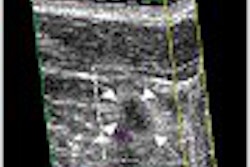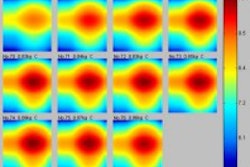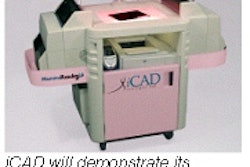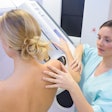Slight differences in breast cancer detection rates between full-field digital mammography (FFDM) and film-screen might boil down to two simple questions: How is the patient being positioned and who is interpreting the images?
Digital mammography has demonstrated numerous technical advantages, such as faster image acquisition, image enhancement capability, and better storage and transmission capabilities for archiving and consultation.
But researchers have been hard-pressed to document a clear clinical superiority for the expensive digital technique, said Dr. R. James Brenner, medical director of breast imaging at Eisenberg Keefer Breast Center in Santa Monica, CA.
"At this point in time there does not appear to be a statistical significance in terms of accuracy between these two modalities," he said to a standing-room-only audience at the 2003 National Consortium of Breast Centers annual meeting in Las Vegas in March.
In a major study comparing the two techniques, some cancers were detected using film-screen imaging only, and others with FFDM exclusively. The differences in detection were not statistically significant, and the researchers reported that discrepancies were tied equally to lesion conspicuity, appearance, and interpretation (American Journal of Roentgenology, September 2002, Vol.179:3, pp. 671-677).
After reviewing the results of this and other studies, including visits to sites conducting clinical trials, Brenner concluded that both interpreter and positioning variability are key.
"All of us have had experiences where, just based on positioning, we see something or don’t see something," he said. "Probably the two most important factors to reconcile whether digital or film is better have to do simply with who interpreted the study and what they decided on management, and on positioning differences."
But that doesn’t leave much hope for those who need definitive answers to justify a $400,000 digital mammography purchase.
In fact, definitive data may have to wait until 2005, when results are available from the Digital Mammography Imaging Screening Trial (DMIST), a $25 million study funded by the National Cancer Institute.
Conducted under the auspices of the American College of Radiology Imaging Network (ACRIN), the trial will ultimately enroll 49,500 asymptomatic women at 19 centers in the U.S. and Canada. All women will undergo both digital and film-screen mammography and will be followed for up to 15 months.
Brenner, who is also a professor of radiology at the University of California, Los Angeles, sits on an oversight committee detailed to DMIST.
"Based on initial results, it’s possible that the specificity of digital mammography will increase," he said. "The number of patient recalls arising from digital exams is decreasing. But sensitivity -- the ability to detect cancer -- has not shown a statistical difference so far."
But the numerous technical advantages of digital mammography create a compelling case for the technology, Brenner contended.
"If for no other reason, digital imaging receives support because there are no longer any lost films," he said. "There is electronic imaging enhancement. And there is improved image quality."
For screening, digital boasts numerous advantages over film-screen. The transition from hard-copy to soft-copy reading is fairly easy, he said. Patient throughput is faster.
"You are able to position the patient, get a preliminary image, and then go on to the next view, instead of acquiring all four views and then taking them to the processor to figure out what you did wrong," he said.
Likewise, from a radiologist’s perspective, reading multiple screening films is an efficient process, according to Brenner.
"Even if you have to manipulate the contrast and magnification a little bit, it doesn’t take a lot of time," he said.
But that isn’t the case when it comes to diagnostic work-ups, which Brenner cites as a major problem for digital mammography devices.
The workstations aren't designed to accommodate multiple image views at full resolution, he said. Moreover, workstations lack a windowing feature whereby a radiologist can switch between two or more patient studies easily.
"Digital mammography workstations are not like home PCs that have 'minimize' buttons for switching between different files," he said. "You have to close down one file before opening another. For a busy diagnostic breast center, workstations can become a real bottleneck."
Vendors are aware of the problem and are working on solving it, Brenner said, reiterating that his major criticism of the field is not in the digital technology, but rather in the workstation applications.
"Digital mammography is the caboose -- the last component of a full digital environment," he said. "It’s important to recognize the special limitations that are imposed on us by this kind of imaging."
By Deborah R. DakinsAuntMinnie.com contributing writer
April 21, 2003
Related Reading
Study examines factors that affect FFDM performance, January 10, 2003
No compromise in breast image quality with lower FFDM dose, December 13, 2002
FFDM fares as well as screen-film for population-based breast screening, December 1, 2002
For ease of use, FFDM wins points with RTs, April 5, 2002
U.S. to fund multicenter digital mammography study, September 5, 2001
Copyright © 2003 AuntMinnie.com



















